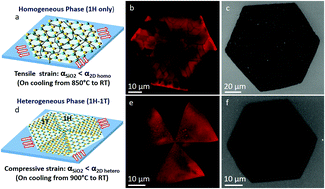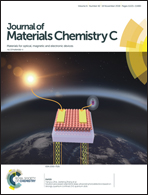Competing thermal expansion mismatch and lattice strain engineered growth of crack free WS2 in-plane heterostructures†
Abstract
Traditionally, the formation of heterostructures is known to impose challenges on the mechanical reliability of devices due to lattice and thermal mismatch strains. On the contrary, our observations on the chemical vapor deposition (CVD) growth of WS2 reveal that the formation of heterophases cancels the competing thermal mismatch and lattice strains and stabilizes crack free monolayer heterostructures while homophase WS2 monolayers suffer from severe cracking. To shed light on this unique thermal strain relaxation in heterophase WS2 monolayers, a systematic investigation with the aid of in situ Raman spectroscopy has been carried out from 4 K to near room temperature (330 K). First-order temperature coefficients of the metallic 1T phase: E2g ∼ −0.0090; A1g ∼ −0.0109, semiconducting 1H phase: E2g ∼ −0.0093; A1g ∼ −0.0143 and semi-metallic 1T′ phase: E2g ∼ −0.0095; A1g ∼ −0.0124 are estimated for the investigated temperature range from 90 K to 330 K. The measured thermal expansions of CVD grown WS2 monolayers with coexisting 1H–1T and 1H–1T′ polymorphic phases are used to estimate the thermal mismatch strain. The tensile strain arising from the thermal expansion mismatch is found to be cancelled by the compressive lattice strain arising in heterophase WS2 monolayers. Phase engineered WS2 monolayers with differential thermal expansions of different polymorphic phases are relevant for the design of robust heterostructure based nanoscale devices.



 Please wait while we load your content...
Please wait while we load your content...